American Folk Art Museum
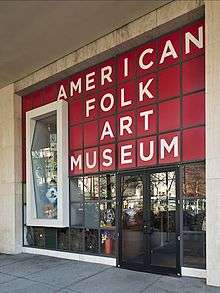 American Folk Art Museum | |
| Established | June 23, 1961 |
|---|---|
| Location | 2 Lincoln Square, Manhattan, New York, United States |
| Coordinates | 40°45′42″N 73°58′41″W / 40.7616°N 73.9781°WCoordinates: 40°45′42″N 73°58′41″W / 40.7616°N 73.9781°W |
| Director | Dr. Anne-Imelda Radice |
| Public transit access |
Subway: Buses: M5, M7, M11, M20, M66, M104 |
| Website |
www |
The American Folk Art Museum is an art museum in the Upper West Side of Manhattan, at 2, Lincoln Square, Columbus Avenue at 66th Street. It is the premier institution devoted to the aesthetic appreciation of folk art and creative expressions of contemporary self-taught artists from the United States and abroad.
Its collection holds over 7,000 objects from the 18th century to the present. These works span both traditional folk arts and the work of contemporary self-taught artists and European Art Brut. In its ongoing exhibitions, educational programming, and outreach, the museum showcases the creative expressions of individuals whose talents developed without formal artistic training.
Admission is free. In 2013, the museum had record attendance with over 100,000 visitors.[1][2]
History
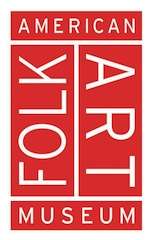
Since receiving a provisional charter in 1961, the American Folk Art Museum has continually expanded its mission and purview. At its inception, the museum lacked a permanent collection, an endowment, and a building. Despite lacking these institutional fixtures, founding Trustees Joseph B. Martinson and Adele Earnest had a vision: the advancement of the understanding and appreciation of American folk arts. In the museum’s fifty-year history, this dedication has held true. The museum’s evolving mission reflects the shifting understanding of American folk art in the contemporary American society.[3]
The Museum of Early American Folk Arts, as it was known initially, held its first exhibition in a rented space on 49 West 53rd Street in 1961. The museum’s collection was launched in 1962 with the gift of a gate in the form of an American flag, celebrating the nation’s centennial.[4] The gift reflected the museum’s early focus on eighteenth and nineteenth-century vernacular arts from the northeast America.
In 1966, after receiving a permanent charter, the museum expanded its name and mission. As the Museum of American Folk Arts, it looked beyond the traditional definitions of American folk art. Its exhibitions and collection began to reflect “every aspect of the folk arts in America – north, south, east, and west.”[5] Founding curator Herbert W. Hemphill Jr. “expanded the notion of folk art beyond traditional, utilitarian, and communal expressions.”[6] Under his direction, the museum began to champion idiosyncratic and individualistic artwork from the fields of traditional and contemporary folk art. In doing so, the museum ushered in a new era in the field of twentieth-century folk art. The 1990s brought new focus to the diversity and multiculturalism of American folk art. Offering a more inclusive vision, the museum began to present African American and Latino artworks in their exhibitions and permanent collections. Director Gerard C. Wertkin announced American folk art’s common heritage as “promoting an appreciation of diversity in a way that does not foster ethnic chauvinism or racial division.”[7]
The museum further established its broadened outlook with the 1998 formation of the Contemporary Center, a division of the museum devoted to the work of 20th and 21st century self-taught artists, as well as non-American artworks in the tradition of European art brut. In 2001, the museum opened the Henry Darger Study Center to house 24 of the self-taught artist’s works, as well as a collection of his books, tracings, drawings, and source materials.
In 2001, the museum chose its current name, American Folk Art Museum. Recognizing that American folk art could only be fully understood in an international context, the word American functions as an indication of the museum’s location, emphasis, and principal patronage rather than as a limitation on the kind of art it collects, interprets, or presents. The museum’s current programming reflects this shift in focus. Past exhibits have included folk arts of Latin America, England, Norway, among other countries and continents.
As the museum's mission developed, so did its effort to establish a permanent home. In 1979, the Museum's Board of Trustees purchased two townhouses on West 53rd Street, adjacent to Museum’s rented quarters at 49 West 53rd Street. In 1984, while waiting to develop the West 53rd properties, the museum continued to organize exhibitions and educational programs from a former carriage house at 125 West 55th Street. Five years later, a new branch of the museum, the Eva and Morris Feld Gallery, opened at 2 Lincoln Square, opposite Lincoln Center for the Performing Arts.
In 2001, a new building on the 45 and 47 West 53rd Street was inaugurated. Tod Williams & Billie Tsien designed the building. From 2001 to 2011, the midtown space served as the museum’s main branch. However, facing increasingly high bond payments, the museum sold the midtown branch to the nearby Museum of Modern Art.[8] When MoMA announced that it was going to demolish the building in connection with its expansion, there was outcry and considerable discussion about the issue, but the museum ultimately proceeded with its original plans.[9][10]
Following the sale, the American Folk Art Museum returned to its previous home at 2 Lincoln Square, where it is currently located.
The collection
Standing as "one of New York City’s great treasures",[11] the museum's 7,000 plus collection has been formed almost entirely through gifts. Spanning a wide variety of mediums, the collection includes over 1,200 paintings on canvas or panel, 1,500 drawings and works on paper, one thousand sculptural objects, one thousand textile items, two hundred ceramic objects, one hundred pieces of furniture, three hundred decorated household items from the Historical Society of Early American Decoration, and two large-scale architectural models.
Additionally, the museum has a large collection of archives, artist files, films, recordings, photographs, original research, historical records, and other assorted and valuable ephemera. Most notably, the museum holds the largest collection of archival materials from self-taught artist Henry Darger.
The collection ranges from early portraits by Sheldon Peck, Ammi Phillips, Asa Ames, and Samuel Addison Shute and Ruth Whittier Shute, quilts and schoolgirl needlework, furniture, and weathervanes to works by acclaimed masters such as Thornton Dial, Morris Hirshfield, Martín Ramírez, Judith Scott, Mary T. Smith and Bill Traylor.
The museum continues to add to its growing collection. In February 2014, it announced the acquisition of both traditional folk art and works by the self-taught. A version of Edward Hicks's (1780-1849) famed The Peaceable Kingdom entered the collection. Notably, this painting, which Hicks gave to his daughter, remained with Hicks's descendants for many years. Achilles Rizzoli’s (1896-1981) architectural portrait Mother Symbolically Represented/The Kathredal was also donated to the museum.
Selected collection highlights
.jpg) Edward Hicks, Peaceable Kingdom, 1829–1831
Edward Hicks, Peaceable Kingdom, 1829–1831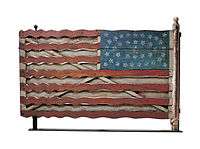 Artist unidentified, Flag Gate, 1876
Artist unidentified, Flag Gate, 1876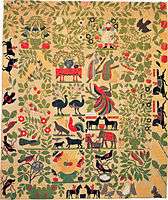 Artist unidentified, Bird of Paradise Quilt Top, 1858–1863
Artist unidentified, Bird of Paradise Quilt Top, 1858–1863.jpg) Ammi Phillips, Girl in Red Dress with Cat and Dog, 1830-1835
Ammi Phillips, Girl in Red Dress with Cat and Dog, 1830-1835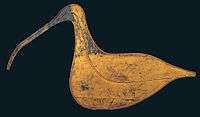 Artist unidentified, Hudsonian Curlew Weathervane, 1874
Artist unidentified, Hudsonian Curlew Weathervane, 1874_and_Ruth_Whittier_Shute_(1803%E2%80%931882).jpg) Samuel Addison Shute and Ruth Whittier Shute, Master Burnham, 1831-1832
Samuel Addison Shute and Ruth Whittier Shute, Master Burnham, 1831-1832.jpg) Hannah Cohoon, Gift Drawing: The Tree of Light or Blazing Tree, 1845
Hannah Cohoon, Gift Drawing: The Tree of Light or Blazing Tree, 1845
Exhibitions
Each year, the museum mounts a number of exhibitions, which span from the traditional folk arts to the more contemporary “self-taught” expressions. The museum’s exhibits frequently examine the works of a specific artist or the significance of a particular medium, such as quilts or tinsel paintings.
Through its exhibits, the museum continues to develop the understanding of folk and self-taught artists. Past exhibits have showcased the works of “undersung” masters, such as Thomas Chambers and Asa Ames.[12] Additionally, the museum has hosted solo exhibitions dedicated to the work of self-taught greats: Martín Ramírez, Eugene Von Bruenchenhein, Willem van Genk, and Bill Traylor.
Past exhibits have also positioned traditional folk art in conversation with more contemporary art. In the museum’s 2008 exhibit, “The Seduction of Light: Ammi Phillips/ Mark Rothko Compositions in Pink, Green, and Red” explored the visual connections between Rothko’s famed color blocks and Phillip’s heightened color palette. In 2013, the museum invited thirteen fashion designers to create an original work, inspired by a piece in their collection. The resulting exhibit “Folk Couture: Fashion and Folk Art” ran from January 21 – April 23, 2014.
By raising traditional folk artists and self-taught artists from the periphery of the mainstream art world, the museum has continued to prove "the worth of instinctive, self-taught artistry."[12]
Stacy C. Hollander is the museum’s chief curator and director of exhibitions. She has been at the institution since 1985 and has held her current position since 1992. Since joining the museum in 2013, Dr. Valérie Rousseau has served as the curator of 20th century and contemporary art.
Notable exhibitions
In 2014, the museum launched the exhibition, Self-Taught Genius: Treasures from the American Folk Art Museum. Featuring more than 100 works of art, "Self-Taught Genius" offered "an intellectually provocative effort to rethink the nature of artistic creativity" from the eighteenth century to the present.[13] Following its New York premiere, the exhibition travelled to six cities, as part of a national tour funded by the Henry Luce Foundation's 75th anniversary initiative.[14]
Past exhibitions
The following is a list of the museum's exhibitions since 2010:
Publications
In December 2013, the American Folk Art Museum launched a fully accessible digital archive of 117 issues of its in-house magazine, Folk Art, formerly known as The Clarion. From winter 1971 to fall 2008, Folk Art, was published on average of three times a year. It served as a forum for original research and new scholarship in the field of American folk art. Topics ranged from traditional arts, such as portraiture, schoolgirl arts, painted furniture, and pottery, to original discourses on under-recognized artists.
Honors
In 2007, it was among over 530 New York City arts and social service institutions to receive part of a $20 million grant from the Carnegie Corporation, which was made possible through a donation by New York City mayor Michael Bloomberg.[16]
In 2013, the Encyclopedic Palace, in the Museum’s collection, served as the inspiration and theme for the 55th installation of the international Venice Biennale. Marino Auriti (1891-1980), a self-taught Italian American artist, created the work as an architectural model for imaginary museum that would house all worldly knowledge. Massimiliano Gioni, artistic director of the Biennale, detailed the enduring relevancy of Auriti’s work. “Today, as we grapple with a constant flood of information, such attempts to structure knowledge into all-inclusive systems seem even more necessary and even more desperate.”
Gift shop
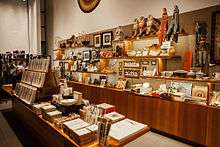
Cited as one of the “World’s Best Museum Gift Shops,” the museum’s gift shop offers gift items, handcrafted in the folk tradition, such as jewelry, personal accessories, frames, toys, objects for the home, as well as note cards, books, and catalogs.[17]
See also
References
- ↑ "News | American Folk Art Museum". Folkartmuseum.org. Retrieved 2014-06-08.
- ↑ "News | American Folk Art Museum". Folkartmuseum.org. Retrieved 2015-06-22.
- ↑ For more information about the history of the American Folk Art Museum, see Gerard C. Wertkin, "Foreword," in Stacy C. Hollander and Brooke Davis Anderson, American Anthem: Masterworks from the American Folk Art Museum (New York: American Folk Art Museum in association with Harry N. Abrams, Inc., 2001), pp. 10–13.
- ↑ "FLAG GATE | American Folk Art Museum". Folkartmuseum.org. Retrieved 2014-06-08.
- ↑ Folk Art, Summer 2001, 21.
- ↑ Brooke Davis Anderson, "The Contemporary Collection: Through The Lens of Language," American Anthem: Masterworks from the American Folk Art Museum (New York: -, 15).
- ↑ Folk Art
- ↑ Taylor, Kate (2011-05-10). "MoMA to Buy American Folk Art Museum Building". The New York Times.
- ↑ Pogrebin, Robin (January 8, 2014). "A Grand Redesign of MoMA Does Not Spare a Notable Neighbor". The New York Times. Archived from the original on July 9, 2014. Retrieved September 29, 2014.
- ↑ Pogrebin, Robin (April 15, 2014). "Architects Mourn Former Folk Art Museum Building". The New York Times. Archived from the original on November 9, 2017.
- ↑ Smith, Roberta (August 2, 2012). "Everyday Treasures Gaze Out to Sea". The New York Times.
- 1 2 Roberta Smith, “As Folk Art Museum Teeters, a Huge Loss Looms,” The New York Times, September 19, 2011
- ↑ Johnson, Ken (2014-05-22). "A Confederacy of Mavericks; Inspiration Made Concrete in 'Self-Taught Genius' Exhibition". nytimes.com. The New York Times. Retrieved 2014-06-07.
- ↑ "$1.6m donation to the American Folk Art Museum". artmediaagency.com. Roubaix, France: Art Media Agency. 2013-06-24. Retrieved 2014-06-07.
- ↑ "alt quilts:Sabrina Gschwandtner, Luke Haynes, Stephen Sollins". American Folk Art Museum. 2013. Retrieved 26 March 2018.
- ↑ Roberts, Sam (2005-07-06). "New York Times: City Groups Get Bloomberg Gift of $20 Million". The New York Times. Retrieved 2010-04-23.
- ↑ Wylie, Erin (2013-11-07). "Quirky Souvenirs from Some of the World's Best Museum Gift Shops:American Folk Art Museum, New York City, Reusable lunch bag, $50". cntraveler.com. New York, NY: Condé Nast. Retrieved 2014-06-07.
Further reading
- Folk Art (formerly The Clarion). Magazine published 1971–2008 by the American Folk Art Museum.
- Anderson, Brooke Davis. Darger: The Henry Darger Collection at the American Folk Art Museum. New York: American Folk Art Museum in association with Harry N. Abrams, Inc., 2001.
- Anderson, Brooke Davis. Martín Ramírez. Seattle: Marquand Books in association with American Folk Art Museum, 2007. A New York Times Notable Book.
- Hollander, Stacy C. American Radiance: The Ralph Esmerian Gift to the American Folk Art Museum. New York: American Folk Art Museum in association with Harry N. Abrams, Inc., 2001.
- Hollander, Stacy C., and Brooke Davis Anderson. American Anthem: Masterworks from the American Folk Art Museum. New York: American Folk Art Museum in association with Harry N. Abrams, Inc., 2001.
- Kelly, Andrew. Kentucky by Design: The Decorative Arts and American Culture: Quilts, Coverlets, and Shaker Material Culture. Lexington: University Press of Kentucky, 2015. ISBN 978-0-8131-5567-8
- Warren, Elizabeth V. Quilts: Masterworks from the American Folk Art Museum. New York: American Folk Art Museum in association with Rizzoli International Publications, Inc., 2010.
- Zimiles, Murray. Gilded Lions and Jeweled Horses: The Synagogue to the Carousel. With a foreword by Gerard C. Wertkin and an essay by Vivian B. Mann. Lebanon, N.H.: University Press of New England/Brandeis University Press in association American Folk Art Museum, 2007. Winner of the 2007 National Jewish Book Award, Visual Arts.
External links
| Wikimedia Commons has media related to American Folk Art Museum. |
- American Folk Art Museum official website
- List of recent American Folk Art Museum exhibitions
- List of upcoming American Folk Art Museum exhibitions
- "Chastened, Folk Art Museum Puts Down Healthier Roots" Robin Pogrebin, The New York Times, April 2, 2013.
- "Crossing borders, ignoring boundaries,", Meghan Daily, The Magazine Antiques, March/April 2014.